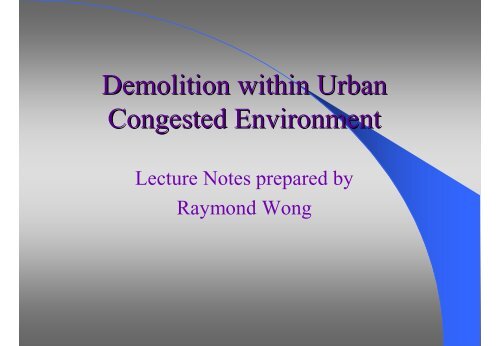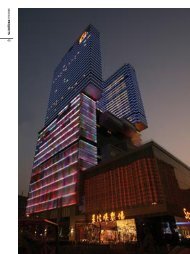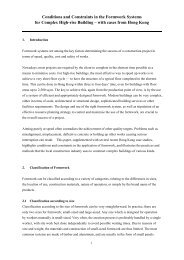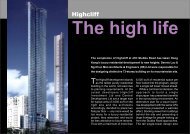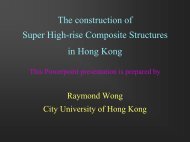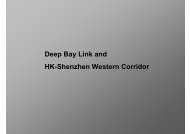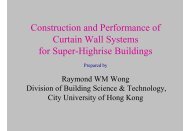Demolition within Urban Congested Environment
Demolition within Urban Congested Environment
Demolition within Urban Congested Environment
You also want an ePaper? Increase the reach of your titles
YUMPU automatically turns print PDFs into web optimized ePapers that Google loves.
<strong>Demolition</strong> <strong>within</strong> <strong>Urban</strong><strong>Congested</strong> <strong>Environment</strong>Lecture Notes prepared byRaymond Wong
<strong>Demolition</strong> work is one of the mostdangerous operations in construction.Reasons/causes:• Easy to cause injury to human workers due to thedifficulty of accessing into or working inside abuilding which is under demolition.• Falling of smaller objects or debris from thedemolishing building.• Falling of partially demolished structure.• Collapse of unstable structure due to originalstructure being disturbed.• Employing inappropriate methods to demolsih
Reasons/causes (continued):• Collapse of heavy demolition equipment due toinadequate support of the partially demolishedstructure.• Collapse of the partially demolished structure due tothe accommodation of large amount of uncleareddebris.• <strong>Congested</strong> site environment that easily causedamages to human workers, or to the third partiesand their properties that are situated nearby thedemo1ition site.
Difficultaccess forworkersentering intoa buildingunderdemolition
Further examplesof difficult accessin demolition jobs
Partially demolished structureis hazardous and may easilycollapse and create accident
Heavy machinery used indemolition may have riskof collapse due toinsufficient support.
Accommodation of toomuch debris duringdemolition can imposeintolerable loading tothe disturbed structure
Typical congesting neighbourhoodcondition for demolishingsmall buildings <strong>within</strong> urbanenvironment
HK Building Department has imposed very strictcontrol to any form of demolition works by theuse of approval & consent procedure.1. Authorized person (AP) should be appointed tosubmit application for approval of the demolition,which includes an appraisal report with a methodstatement proposed for the demolition.2. Building Department will approve the work subjectto the satisfying of all precautionary measurespursuant to the Building (<strong>Demolition</strong> works)Regulations, hoarding and covered walkways or anyother conditions as required.
3. After approva1 is obtained, another 2 stageconsent procedure are still required before startingthe actual demolition.4. Stage 1 is to obtain the consent for carrying out allprecautionary/temporary works which include thehoardings, covered walkways, scaffolding, catchfans, dust screens and shoring etc.5. In case the provisions in Stage 1 is completed andto the satisfaction of the Building Department,Stage 2 of consent for the actual demolition can beapplied.
In the appraisal report, the followinginformation should be included1. Structural survey of the building to be demolished2. Photographic record of the site and its adjacentbuildings, slopes and retaining structures.3. The overall height of the structure above groundlevel and the proximity to adjoining buildings.4. Information on the type of building, its strudura1support system, the principal materials of itsconstruction, the degree of deterioration and theeffect of demolition etc.
<strong>Demolition</strong> PlanForming part of the submission information, the<strong>Demolition</strong> Plan should include:a) A set of drawings showing :- the location of the building to be demolished- other existing structures and facilities in vicinityb) Proposed methods of demolition.c) Proposed shoring and precautionary measures foradjacent buildingsd) Proposed shoring and protection for the buildingto be demolished
<strong>Demolition</strong> Plane) Proposed methods of handling and disposing ofthe demolished materialsf) Proposed sequence of carrying out work.g) Detai1of equipments used, with methods ofraising, lowering or supporting the equipments.h) Structural calculation to justify the proposali) Proposed arrangements for site supervision
Typical dust screen and fansprovision to protect buildingand minimize disturbance topublic during demolitionCatch fan
Provision of Hoarding as aprotection to public
Provision of Hoarding as a protection to public
Provision of Fenceand screen to preventfalling of debris andgetting out of dust
Detail of protectionscaffold, screen andcatch fan
Shaft for fallingof debrisCommon ways to get rid of thedemolished debris – to controlthe falling of the debris into apre-determined vertical shaftformed on the floor slabs
Temporary props erected tosupport heavy equipment
Erection of shoring to supportaffected structurea) Basement demolition (left)b) A nearby retaining wall (right)
Typical sectioning/sequencing arrangementof work duringdemolition – demolishfrom exterior inward
Typical sectioning/sequencing arrangementof work duringdemolition – demolishfrom one side to theother side of building
Protection measures to publicduring demolition processThe following concerns related to the protectionand safety of general public or their propertiesshould be provided in the demolition process1. Overall structure of the adjacent buildings(stability).2. Party walls and external walls of adjacentbuildings (sealing and waterproofing)3. Foundations of other buildings which may beaffected.4. Public roadway and traffic.
Strengthening of party wall of adjoining building after demolition(by the use of stiffening frame)
Strengthening of party wall ofadjoining building after demolitionStiffening frame to strengthenan exposed party wall
Timber raking shore as a temporarysupport to adjacent buildingShoring support to adjoining building after demolition
Method of demolitionGeneral ConcernsThe choice of choosing a demolition method dependson a number of factors such as the projectconditions, site constraints, sensitivity of theneighbourhood and availability of equipment etc.In general, top-down methods are applicable for mostsites, particularly for those situated in busy urbanareas. Other mechanical methods applied from theoutside of a building may be suitable for projectsthat have sufficient clear spaces.
Method of demolitionGeneral Concerns (continue)For structural projections such as balconies, canopiesand verandahs extending beyond the building lines,demolition by hand held tools or the cut and liftprocess may be a safe solution.Each site has its specific features and conditions. Themethod, including detail procedures, shall bedesigned to accommodate the specific projectrequirements. In general, demolition should bedone in the reverse order of construction.
Method of demolition<strong>Demolition</strong> by human operatives –This method particularly suitable for use in smallersite with congested space where larger machinecannot be employed.In this case, human operatives are used in thedemolition process using simple electrically orpneumatically powered tools such as picks,hammers, wire cutters, welding cutters or handdriven hydraulic jacks etc. to carry out thedemolition of individual elements.
Typical demolitionarrangement done byhuman operatives
Slab with the sidesdisconnected readyfor dismantleTypical demolitionarrangement done byhuman operatives
Method of demolitionDeliberate collapse method –<strong>Demolition</strong> by deliberate collapse consists ofsystematic removal, or weakening of the keystructural elements to induce the collapse of thestructure.However, when applying this method, severalprecautions should be observed, such as:• Sufficient distance of collapse should be provided• Collapse procedure should be carefully designedso that there is no pre-mature collapse or collapseout of the anticipated area.• Control height of building structure to becollapsed
Method of demolitionUsing of applied pulling/pushing forcesConnecting structural members are disconnected firstallowing part of the remaining structure to bedragged down by the use of some pulling/pushingequipments such as powered jack, winchingmachine, pulley systems, pushing arms, poweredblocks or from the pull/push of a hydraulicexcavator.However, a firm base in the demolishing building isrequired such as basing on an undisturbed corewall or a strong column section for the applyingof the pulling/pushing force.
<strong>Demolition</strong> of anexternal wall bypull-down methodusing pully
<strong>Demolition</strong> of anexternal wall by pulldownmethod usingexcavator arm
Disconnectedexternal wall readyto be pulled downby an applied force<strong>Demolition</strong> done byapplying a pulling force toa portion of structureRemain fragments frompulled-down structure tobe removed afterward
Method of demolitionUsing of wrecking ball -The use of wrecking ball method requires a craneequipped with a steel ball. The destruction of thebuilding is caused by the impact energy of thesteel ball suspended from a crawler crane.The wrecking ball can be operated outside or inside abuilding. In case the process is operated inside abuilding, sufficient clearance from the buildinginterior should be made first (by having theinterior portion of the building demolished)This method also demands experienced operators inorder to handle the wrecking ball and control thedemolition sequence in a safe manner.
Swing action ofwrecking ballVertical drop ofwrecking ball
Method of demolitionUse of powered plant or demolition machine -The principle of demolition by machine is typicallythe same as the top-down manual method, except thatmost of the demolition begins with the lifting of themechanical plant on to the building top floor.Powered plant such as crawler mounted breakinghammer are used in the demolition process andexcavating machines with bucket are used in theremova1 or handling of the demolished materials.However, due to the weight of these machines, theyshould be properly supported such as by the use ofsteel props no matter in still or in operating condition.
<strong>Demolition</strong> by the help ofmechanical plant – pneumaticbreaker and bucketedexcavator
Lifting themechanicalequipment to topof buildingBuilding before demolition<strong>Demolition</strong> using top-down method using machines
<strong>Demolition</strong> using properly proppedexcavating/breaking machine<strong>Demolition</strong> using top-down method using machines
<strong>Demolition</strong> using top-downmethod using machines –typical floor cycle andmachine movement
<strong>Demolition</strong> using top-downmethod using machines –typical floor cycle andmachine movementMoving down of the breakingmachine to the lower floor
<strong>Demolition</strong> using top-downmethod using machines –typical floor cycle andmachine movement
<strong>Demolition</strong> of 2-wayfloor slab usingmechanical breaker<strong>Demolition</strong> of floor shouldbe started from the middle
Safe practice – <strong>Demolition</strong>of cantilever slabUsing manual methodUsing cut and remove method
Some more examples ofmechanical means to demolish
Method of demolitionUsing saw cut method –This method is suitable for alteration and additionalworks where accuracy is important and restrictionon noise and vibration is required.It can be used to cut concrete slab and wall elementsinto segments or for the forming of openings,breaking into existing structure like a basement,servicing tunnel, flyover, or other part of aninhabited building in the process of alteration orrenovation works.
Method of demolitionUsing saw cut method (continue) –Saw cutting can be done using the followingmethods:• wire saw cutting• diamond core stitch drilling• disc saw
<strong>Demolition</strong> using dis saw cuttingSet-up and mounting of thesaw dis on wall
<strong>Demolition</strong> using diamond coreAn openingformed on floorfor the insertionof a steel prop
<strong>Demolition</strong> using wire sawing
Method of demolitionUsing cut and lifting method –Cut and lifting involves the initial cuttingof the structure into individual pieces orsegments, and then lifting the pieces bycrane onto the ground for furtherdemolition or hauling away.Special precaution should be made whenapplying this method for demolition suchas:• weight of the cut segment may causeextra loading to the remaining structure• lowering of the segment can bedangerousLowering of segment from afootbridge after dismantled by saw-cut
Method of demolitionUsing of hydraulic clamp or roboticbreaker –Specially designed breaking/cutting machines,usually track mounted, are used to demolishsome smaller structural elements such as thinwalls, stairs, slab or parapet etc. when usingthis kind of equipment, planning for accessingthe machines into the working spot is essential.
<strong>Demolition</strong> usinghydraulic clamp orrobotic breaker
Method of demolitionBy implosion (explosive) –If using this method to demolish a building, contractorshould carry out a comprehensive risk andenvironmental assessment on the effect of implosionon the neighbourhood.A detail demolition design is also important, whichshould cover:• Method to pre-weaken the structure (e.g. demolish someload taking structures)• Placement of explosive• Time-delay design to allow the building to collapseunder control director and location
Method of demolitionBy implosion (continue)charges of explosive are placed <strong>within</strong> the fabric ofstructure and detonated to cause partial orcomplete collapse. Competent explosivespecialist is required when demolition is to bedone by using explosive.There are numerous types of explosives for use forvarious types of demolition (sometimes includingnon-explosive agent). Consideration such as thespacing and depth of explosive to be located, theamount of explosive to be used, or the degree offragmentation required in order to control theboundary of demolition etc., are requiredthroughout the planning and operation process.
Removal of demolished material or debris<strong>Demolition</strong> will generate huge amount of debris. Thesafe and effective removal of such constructionremains will be a prime concern in the operation.In this case, before and during demolition, thefollowing provision should thus be provided:• Overall debris disposal planning• Traffic routing for debris handling and vehicularaccess etc.• Adequate number of chutes for debris disposal• Sorting of non-structural materials such astimber and metal for recycling.
Removal of demolished material & debrisDebris created by demolition is usually collected toone or two pre-arranged shafts in the building andthe debris are allowed to fall or drop freely fromthe shafts, by the push of a bulldozer or alike,down to a safe debris collecting areas for furtherdeposal. Since the accommodation of a certainamount of debris is expected, the areas around theshaft should be properly fenced or propped so thatthe extra weight of the debris can be taken up.Accommodation of debris is often dangerous for theymay impose extra load to the floor or wall (ifleaned against onto). Debris should be clearedaway the structure at the earliest possible.
For larger demolished materials, such as a sectionof a beam or column member, they can behoisted down using steel rope, lifting arms orwinch etc.If the site area is large enough or where situationallows, a section of building may be demolishedfirst. The area vacated can be used for thehandling of the debris. In this case, a mobilecrane may be employed to lower the debrisusing a bucket or skip.
Portion of the buildinginterior being cleared out fordebris handling purposes
Collected metal and othervaluable scrape for recycle
<strong>Demolition</strong> for special structureThe following structure should require veryspecial attention during demolition:• Precast elements• Prestressed elements• Cantilever structure• High headroom or Large-spanned elements• Structural elements under special jointingarrangement (e.g. hinged or pin-jointed)• Composite or steel structure
<strong>Demolition</strong> for special structureThe following structure should require veryspecial attention during demolition (continue):• Hanging structures• Transfer plate and deep beams• Special floor structures - waffle floor, flat slab• Arches, trusses or girders structures• Cladding or curtain wall
<strong>Demolition</strong> for special structureThe following facilities or buildings should requirevery special attention during demolition:• Buildings located in contaminated site• Buildings used as oil or dangerous goods storage• Marine structures• Underground structures (tunnel, basement orfoundation)• Soil retaining structures
Disconnection of utilities servicesbefore demolitionThe following utilities should be properly sealed ordisconnected before the commencement ofdemolition:• Electricity and gas• Gas and water supply• Vent shaft or any underground access• Drainage and sewage systemsMajority of these utilities services are locatedunderground and can hardly be seen visually. Adetail survey should be done before hand to ensurethey are found and disconnected.
<strong>Environment</strong> concerns in demolition<strong>Demolition</strong> is a dirty and dangerous process. In viewof ensure such works are done properly withoutcausing any unnecessary interference to generalpublic, the following areas of environmentalconcern should be noted.• The proper recycle or disposal of the constructionwaste• Treatment of harmful material (e.g. asbestos orcontaminated waste)• Control of dust generation• Control of noise• Control of waste water (including rain watercarrying large amount of mud running out from site)
Other precautions to be noted1. When handling the debris, continual spraying ofwater onto the debris can help suppressing thecreating of dust.2. Better work coordination should be maintained toensure no worker is working inside the buildingwhen the debris is being pushed down from thedebris shafts.3. Secure all the partially demolished structures byprop, wire or bracing etc. to ensure the areas aresave and will not fall down, at least temporary, andhurt the workers who is working around.
4. When a building is attached to other buildingsnearby, the structure to be demolished should firstbe detached from the adjoining structure by handdemolition techniques.5. Very special attention should be made to anydemolition work that is carried out along theexternal perimeter of building for the falling ofobjects may cause great casualty to third partybelow.6. Maintain a safe emergency access all the timeduring demolition.
Jetting water to the spotwhere demolition takesplaceProtect by secure a freestanding external wallsection by steel ropesSteel rope
Maintain a safe access forworker during demolitionFence off the vertical shaftfor the removal of debris
Protect exposedretaining structure afterdemolition by steelshoring or by remainingbuilding frame of theold structure
Free standingwall withoutsupportAvoid letting along section ofwall free standingwithout support
Safe practice – <strong>Demolition</strong> of an externalcolumn by pull-down method using pull rope
Some other very complicateddemolition cases
The redevelopmentof the Lee GardensHotelVarious phases of basementdemolition – part of thebasement being removed forconstruction of the pile capfor the future building
Continual stages of the basement demolition with theincorporation of other substructure of the future building
The redevelopment of the Lee Gardens HotelThe demolition of the basement structure working at thesame time with the construction of the future building
The redevelopment of the Lee Gardens Hotel
The redevelopment of the Hilton Hotel<strong>Demolition</strong> of the basement structure of the previous Hilton Hotel – thelower basement was backfilled to maintain stability of the disruptedbasement structure before the commencement of the new basement
The redevelopment of the Hilton Hotel<strong>Demolition</strong> of the basement structure ofthe previous Garden Road Carpark
The Millennium City in Kwun Tong<strong>Demolition</strong> of the basement working at the same time with the building foundation
Concerns when demolishing a basementBasement is a soil retaining structure. If demolishednot in a proper manner, the basement and thesurrounding may collapse and cause seriousdamage both inside and outside the basementboundary. The following concerns should be takenwhen doing the demolition work:• Careful planning of work is important (usual todemolish in smaller section and in coordinatedphases)• Proper shoring should be provided to the basementduring demolition
Concerns when demolishing a basement(continue)• Because the upper structure has been remove, thebasement (and the soil below) may have upliftingproblem.• There may have ground water problem.• Existence of old foundation structure (usuallyrequired to be removed)• Accessibility into basement (and removal ofdebris) is difficult.
An accident case – the collapse of theAsian Trade Centre at Yau TongThe Asian TradeCentre beforethe collapse
Existing structure of the Asian Trade Centre1. Building size:about 45m by 50m on plan and 25m high2. Structural form:- flat slab structure with limited amount of beams onthe building edges and corners- non-load bearing reinforced concrete external wall- arranged in approx. 8m span in 5 x 6 bay grid- strength of concrete 30 N/mm 2 (judge accordingto speaker’s experience)
The site as seen after the collapse on 30.11.01 (viewing north)
The site as seen on 30.11.01 (viewing south)
The site as seen on 30.11.01 (viewing west)
The site as seen on 30.11.01(viewing at J/O Sze Shan Street and Shung Shun Street)
The damage – the wreck of two out of the fivebreaking/excavating machines used for demolition
The damage – the 6-storey building collapsed inwardforming a heap of debris about 6m high from ground
Adjoining buildingSeparatingjointThe damage – fortunately, the collapse does not damagethe adjoining building which separated from the collapsedbuilding by a separating joint only a few millimeter apart
The remain – a section of the external wall onthe west side of the building
The remain – aportion of buildingstructure at thecorner at J/O SzeShan Street &Shung Shun Street
Observation – all the fallen columns centered inward indicatesthat the collapse orientated somewhat from the building centerParty wallbeing pullinward
Observation – with the columns basically remain intact while no traceof floor slab can be observed in the remain indicates that the floorstructure in general is a weak source that may cause the collapse
Observation – the exposed steel bars on the cut-edges indicates thecollapsing structure fell rapidly and produced tremendous pulling force thatfail to keep the floor in position. There is no trace of floor concrete adheredto the bar, again indicates that strength of concrete may be sub-standard
Observation – further evidence of possible floor failure.More than 3 storeys of floor slab crushed to rubble anddetached completely from the columns
SteelpropObservation – the steel propsused as temporary support forthe positioning of the heavybreaker machines seeminsufficient for the purpose
Props shouldrest on bearingplate ratherthan directlyon floor toavoidconcentrationof loading
Observation – the accommodation of large amount of debrisabove the floor impose great loads to the structure
End of PresentationPlease refer to the “Code of Practice for<strong>Demolition</strong> of Buildings” published by theBuildings Department, HKSAR Government(can be downloaded from the homepage of BD athttp://www.info.gov.hk/bd/english/documents/index.html)


